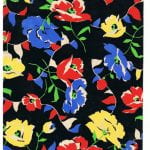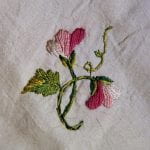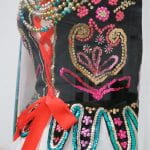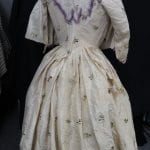Aims, use of the dress history collection and copyright
Aims
- To offer all students and staff at the University of Brighton, only, direct access to, and the opportunity to handle, closely examine and photograph, historical and world fabrics, garments and accessories and to use these artefacts in staff teaching sessions and for student/staff research and publishing. Access by students in arranged through their course tutors.
- To offer this, exceptionally in museum practice terms, without the wearing of white gloves, with full permission to closely handle and photograph all artefacts. Whilst museums, for reasons of conservation are properly unable to offer such access, we can. We feel that touching fabrics/clothing and closely examining their construction, making up, embroidery, printing etc. is vital to the academic learning process in dress and textile history, for both studio-based design students as well as for historians. This is thus essentially a handling collection – transportable to teaching rooms without fuss. We have basic security set in place – use of pencils when handling, and storage of artefacts in acid free tissue paper, boxed, or hung in clean, aired spaces.
- To encourage the use of this collection within material culture research particularly within the Fashion and Textile Design BA(Hons) and Fashion and Dress History BA(Hons) programmes as well as the MA in the History of Design and Material Culture.
- To build up on this site an on-line collection of University of Brighton staff and student research on our artefacts.
- To offer on the web site a completed catalogue of the entire collection, for all interested staff and students. (Work on this has been on-going with the generous help of Ilaria Coser, Cheryl Roberts and E-J Scott.)
- To maintain this Teaching Collection web site for open use of images, with the exception of the requirement to seek permission for publishing any images.
Use
We have built the use of this collection into our teaching programmes at all levels over the last 10 years. Examples include, on the Fashion and Dress History programmes – Case Studies, Final Year Dress and Fashion History Special Study seminars and for constant use in teaching the first and second year BA Hons and MDes fashion and textiles design students. Staff regularly borrow artefacts and set up teaching exhibitions in lecture rooms for specific themes – ie Indigo blue print; ready to wear in the 1900-1920 period or selections from the 1930s or 1950s or 1960s using garments and related fashion magazines and catalogues. African dress and textiles form other exhibitions- including displays of export prints; the small collection of tourist craft textiles and Fair Trade examples are also in regular use. Garments have been used in fashion drawing classes and in weaving and printed textile research.
Finance
We have done all this without major funding or fund raising so far, relying on volunteer student and staff support and indeed artefact contributions. Our Head of School has supported basic costs and offered support for further storage improvements. Nothing has been expensively purchased, nor will it be. We do not aim to purchase or collect the highest quality museum-worthy garments because we have neither the finances, specific conservation facilities nor permanent curators to take care of such precious items. Fundamentally, this is a collection for hands-on teaching use, not for conservation.
Storage
Our collection is stored in the School of Humanities in one teaching room (Room 404) and in the nearby Staff Common Room, enabling easy staff access. Both rooms have security door tabs. The artefacts are either stored in dated/themed boxes or hung on rails, also in themed and dated order. Two groups of clothing are arranged by ‘collectors’ – as case study examples for use in teaching issues surrounding the formation of dress collections.
Access
Only University of Brighton staff are permitted to take out objects, whilst students can access the collection through their tutors. We have no formal curator but one part-time member of staff, Cheryl Roberts and Prof Lou Taylor take responsibility. We have a formal signing in and out book and staff return garments after use. We can make special arrangements,for groups to study specific items, as we did for a joint study day held in 2012 with a group from the RCA, MA History of Design and a for a University of Brighton Dress History Collective Study Day in March 2013, with colleagues from the Fashion History Group of the Institute d’Histoire du Temps Present (CNRS), Paris. As we have no curator to deal with outside inquiries, we hope this web site, once completed, be useful in offering wider access to our artefacts.
Copyright
- Use of website images of artefacts in this collection by researchers/students in unpublished academic work. This is free with acknowledgement to ‘The University of Brighton Dress and Textile History Teaching Collection, School of Humanities, University of Brighton.’
- Use of our Teaching Collection website images in academic publications. This is also free but formal permission must be sought from the University of Brighton Dress and Textile History Teaching Collection, c/o Lou Taylor and acknowledgement made to ‘The University of Brighton Dress and Textile History Teaching Collection, School of Humanities, University of Brighton.’
- The Fielden Royle Textile Print Collection 1920-60: Use by researchers/students of website images of artefacts in this specific collection in unpublished work: this is free, with acknowledgement to the copyright holder, Malcolm Ross and ‘The University of Brighton Dress and Textile History Teaching Collection, School of Humanities, University of Brighton.’
- Use of website images of artefacts in this specific Fielden Royle collection in publications: this is also free but formal permission must be sought from Malcolm Ross, the copyright holder and acknowledgement made to him and to ‘The University of Brighton Dress and Textile History Teaching Collection, School of Humanities, University of Brighton’ via Lou Taylor.
- Commercial use: for copyright permission and costs contact Malcolm Ross directly at 17, Sunnyhurst Lane, Darwen, Lancashire, BB3 1JN and e-mail malcolmjross@hotmail.com.
Donors
We thank all our generous donors who include: Rosemary Bingham, Pearl Binder, (Lady Elwyn Jones), Susan Bishop, Anna Blanchard, Monica and Rachel Brewis, Michael Collier, Ilaria Coser, Courtaulds plc, Lois Davidson, Ditchling Museum, Emmanuelle Dirix,Veronica Doubleday, Amira Driscoll, Christina Forder, Florence Edwards, Yvonne Fleury, Christine Ghent, Rasma Grava, Ciara Green, Elizabeth Griffiths, the Guillemard family, Veronica Isaac, Dan Jones, Katherine Ladd, Joanna Lumsden, Trinny Marr, Marie McCloughlin, John Miles, Lucy Noakes, Muriel Pemberton, Louise Purbrick, Cheryl Roberts, Aniko Sukaly, Frances Tempest, Worthing Museum which has donated unwanted garments for many years, so thanks go to Anne Wise, Kate Loubser and Gerry Connolly, Hannah Warwick for the Trotta Collection, Jo Woodhead, Ray Watkinson, Pat Wolfe and Eileen Yeo and many other students and colleagues over the years.
Prof Lou Taylor, 2013












